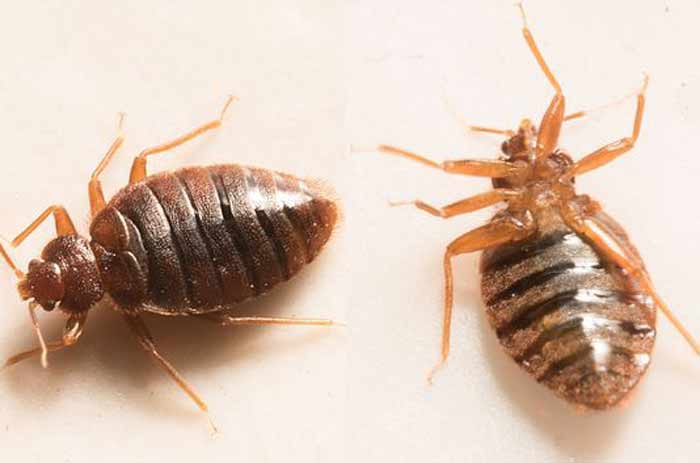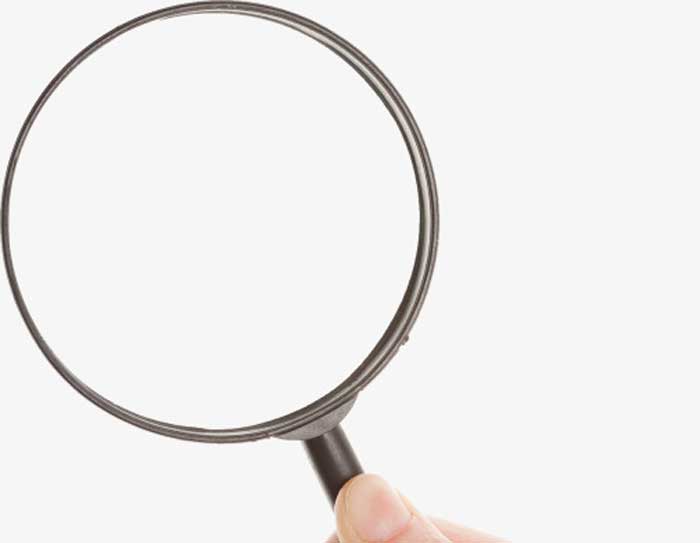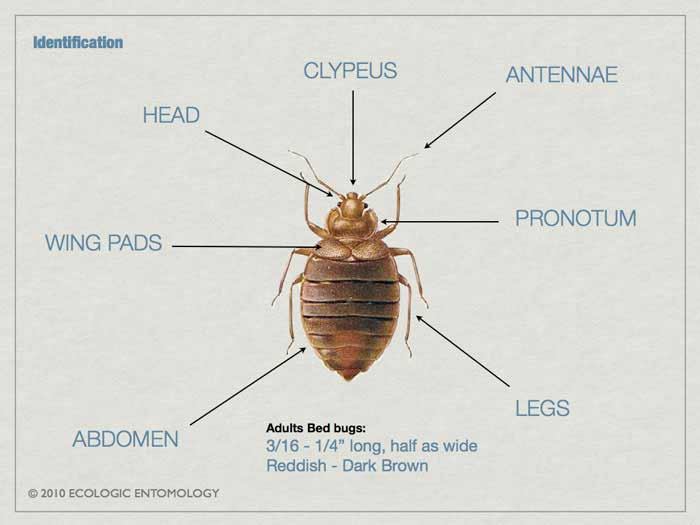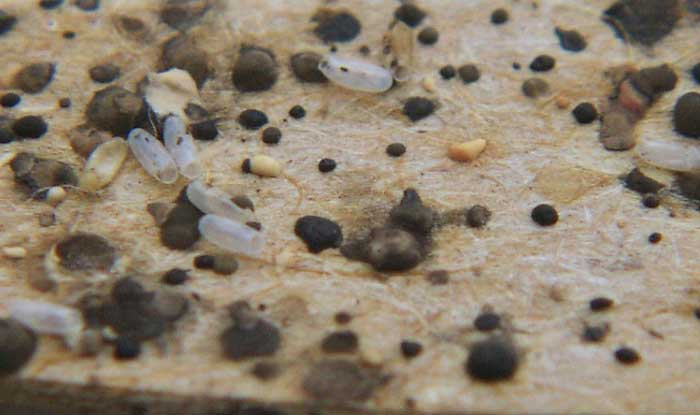Following the increased cases of bed bug infestations, you need to clearly understand how bed bugs look like so that it is easy to spot them. This article critically examines the size of bed bugs, their color and their general anatomy.
Bed bugs are tiny but you can see full-grown adult bed bugs with your naked eyes. Nymphs or rather baby bed bugs are quite invisible and may not be easy to identify using the naked eye. The baby bed bugs are not only very tiny but they are also translucent.
Table of Contents
Do Bed Bugs Look Like?
Adult bed bugs are wingless, oval, they have a flat body and they are rusty red in color. All these features make it very visible and you hence do not have to strain to see the bugs with your naked eye.
Nymphs are colorless and hence they cannot be seen not unless you are extremely keen or use some light or a magnifying object. Due to the noted difficulty in seeing the nymphs with your naked eye, there are tools that have been improvised to aid in detecting these bed bugs.
It is important to know how you can easily spot the baby bed bugs when doing a thorough search in your house for presence of bed bugs. Below are the tools you may find very useful;
A flashlight
Whether adults or nymphs, bed bugs can sometimes be hard to find if you are using your naked eyes. A flashlight is very useful in finding out whether there are bed bugs hiding in cracks and crevices in your house, or other hard to see places. You are advised to use a very bright flashlight, probably, one with fresh batteries.
A magnifying glass
A magnifying glass gives you a closer view of the bed bugs. It makes the very small bed bugs appear way bigger making it easy for you to see the bed bugs.
Ensure you get a very large magnifying glass so that you can cover a large area by a single glance. A large magnifying glass makes close-up examinations easier especially for newly hatched bed bugs.[1]
Bed Bug Size-How Big are they?
Bed bugs are very tiny insects and that is why they are able to hide almost everywhere. Below is a discussion on the bed bug actual size as well as factors that determining the size of the bed bugs.
Bed Bug Actual size
A bed bug’s size depends on what stage of its life cycle it is in. An adult bed bug that has not yet fed has a size of approximately 3/16’’. When the bed bug feeds, it swells and there is a noticeable increase in its size. The growth in length of the bed bug after feeding increases to approximately 1/5’’.
Why Big & Small Bed Bugs
Some bed bugs are bigger than others. As mentioned above, a bed bug that has fed is bigger than one that has not fed yet.
Bed bugs that can reach a blood meal often will appear more swollen than those that are starved. That aside, bed bugs that are on their early life stages appear smaller than adult bed bugs.
What factors will determine the size of a bed bug
Stage in its life cycle
A bed bug develops from the egg to four stages as a nymph before it is an adult. During its life cycle, it keeps increasing in size as you move from one stage to another.
This is to mean that a nymph is smaller than an adult bed bug. A nymph could be as small as 1.5mm. The nymph biggest size is about4 to 5mm.
Feeding habits
A bed bug that has fed is bigger than one that is starving. The more a bed bug feeds, the bigger it is and the more visible it is.
Further Reading: How long can bed bugs go without feeding?
What color are bed bugs
Immature bed bugs, commonly referred to as nymph, are translucent, that is, they are almost colorless. When they first hatch, the bed bugs are colorless but they become brown as they grow. Adult but unfed bed bugs have a rusty brown color.
Adult bed bugs that have fed on a blood meal appear to be red brown in color. The additional red color after the mature bed bug feeds can be explained by the color of your blood.
The color of the bed bugs determines how visible they are. When immature, the bed bugs are less visible since they are translucent. An adult bed bug that has had a blood meal is more visible than one that has not fed.
There are several factors that determine the color of the bed bugs. Some of them are discussed below;
Feeding
Bed bugs that have fed are more visible than those that have not fed. As sated above, a bed bug that has had a blood meal will have an extremely visible color which is red-brown as opposed to the unfed bed bug which is just brown in color.
Stage in life cycle
An immature bed bug is almost colorless meaning you can hardly see it. A bed bug is however very visible once it is an adult since it acquires a brown color which you can easily see with your naked eye.
Anatomy-how many legs do bed bugs have?
Bed bug legs
Bed bugs have six legs which they use for crawling. For each minute, bed bugs can crawl for 4 feet. The bed bug uses its claws to grip rough surfaces and getting hold of the host when feeding. The bed bug’s legs however do not allow them to climb smooth surfaces since they do not have suction pads.
Other parts of the body
Generally, bed bugs have 3 segments on its body. These are the head, thorax and abdomen. Discussed below are other parts of the bed bug apart from the legs;
Proboscis
This is a small tube under the mouth of the bed bug. It elongates at the time the bed bug wishes to feed.
It is this tube that injects the anti-coagulating saliva so that you do not experience any pain as it withdraws blood from your skin or the skin of your pet.
The University of Kentucky explains that, using the proboscis, bed bugs draw approximately 0.0055milliliters of blood for each bite.
Antennae
A bed bug has antennae on its upper part of the body. The antennae are usually two. There are four segments on each antenna. These antennae are half as long as the body of the bed bug.
It is the antennae that guide the bed bugs to their hosts. They act as sensors.
Eyes
Bed bugs have two compound eyes. For this type of eyes, a single eye has ommatidia which refer to many repeating units. This explains why the bed bug’s eyes are very sensitive to any movement.
Head
The head of a bed bug is broad. It is attached to the thorax.
Thorax
Below the head of the bed bug is the thorax. The thorax is the part of the body in which the legs of the bed bug are attached. This enables the bed bug to make movement.
Abdomen
This part of the bed bug’s body has eleven segments. The segments expand easily and this allows the bed bug to fill up with blood when it feeds.
his flexibility also allows it to plump up. While the male bed bug has a pointed tip abdomen, the female bed bug has a rounded tip abdomen.
What does bed bug poop/Feces/Droppings look like?
Among the common signs that bed bugs leave signs are their droppings. Bed bug poop is used as one of the signs in identifying presence of bed bugs. For this to be successful, you will need to know how exactly bed bug droppings look like.
Bed bugs feed on a blood meal and so, after bed bugs bite you, they later leave behind droppings which constitute of digested blood.
Bed bugs will leave these droppings in form of tarry tiny spots on your bed or even clothes and furniture. Once the droppings dry up, they are no longer the color of blood but rather, they turn black. The normal color of bed bug feces is hence either dark red or black.
The droppings are also found to have rust color in the case where they do not turn black. The droppings are the size of a dot from a marker pen. Bed bug droppings can be found anywhere in your house.
Since the bed bug droppings may sometimes resemble the droppings from other insects, you are asked to use the droppings together with other signs such as bed bug eggs to determine whether or not your house is infested.[2]
Are bed bug feces hard or soft?
Bed bug feces are not hard. Most people report that the droppings feel soft and when touched, they are likely to smear. These droppings are sticky to some degree. However, the consistency of bed bug feces may vary.
- How to Prevent Bed Bugs-Bites while Sleeping at Home, School, Hotel & Travelling
- How to get rid of Bed Bugs on Clothes-Can they Live, Bite through or Travel on Laundry
- Fumigation for Bed Bugs-Cost & Preparation
- How to get Bed Bugs out of Carpet with Cleaner & Powder
- How Long do Bed Bugs Live Without Food, Host, Air, in Cold & After Spraying
- Bed Bug Rash on Skin, Pictures, Treatment, Allergy & Symptoms
- Where do Bed Bugs Hide and how to Find them
- Mosquito Bites vs Bed Bug Bites-What’ are the differences
- Identifying Bed Bug Eggs- How they look like, Images & destruction
- How do you know if you have Bed Bugs-Symptoms & Signs
- Bed Bug vs Spider Bites- Differences with Pictures
- Bed Bug Sniffing Dogs-How they smell, Sense, Roscoe, Breeds & Cost
- What are Bed Bugs? Names in other Languages
- Where do Bed Bugs come from? Causes, how you get them & Start
- How to Kill/Get Rid of Bed Bugs Fast Yourself Naturally for Good
- Bed Bugs in Hair Symptoms, Pictures & Get rid
- Types of Bed Bugs
- Bed Bug Poop/Droppings-How it looks like, Pictures +Identification
- Bed Bug Shells, Cast Skin & Exoskeleton
- Can you See Bed Bugs with the Naked eye? Pictures, Size, Color & Anatomy
- Dust Mite vs Bed Bug Bites
- Bed Bug life cycle-Eggs, Baby(Nymph) to Adult Stages & Pictures
- How to Detect Bed Bugs-Detectors, Light & Verifi Reviews
- How to know if Bed Bugs are gone after Treatment & what to do
- Will Bleach Kill Bed Bugs-How does it work?
- Best Bed Bugs Traps- DIY Homemade, Co2, Yeast + Reviews
- How to Deal with Bed Bugs in your Car
- Bed Bugs in Couch-Covers, Signs & How to Get rid
- How to Kill Bed Bugs with Steam: Best Steamers & Guide + Tips
- Does Alcohol Kill Bed Bugs? Rubbing, Isopropyl & Percentage
- How Long do Bed Bug Bites Last, Take to Appear, Go Away & Heal
- Natural Predator of Bed Bugs-What Insects/Bugs eat Bed Bugs?
- Can Bed Bugs Live in TVs & Other Electronics? How to get them out
- Do Bed Bug Bites Itch or Hurt?
- Bed Bug Interceptor-How it works, DIY & Reviews
- What do Bed Bug Bites look like? Pictures & Identification Steps
- What Attracts Bed Bugs & things they Hate /Dislike Most
- Can Bed Bugs make you Sick? How are they Dangerous?
- Can Bed Bugs Fly-Do they have Wings-How Far can they Travel
- Diatomaceous Earth for Bed Bugs-How to Use & Best Reviews
- DIY Bed Bug Heat Treatment: Success Rate,Temperature Chart, Preparation & Reviews
- Does Vinegar Kill Bed Bugs? Can it be Used for Bites?
- How to Get Rid of Bed Bugs on Mattress- Best Covers, Protectors & Encasement Reviews
- Can Bed Bugs live on or Bite Dogs & Cats (Pets)?
- Bugs that look like Bed Bugs-Beetles & Others that Resemble or Mistaken
- Bed Bug Bombs-Do Foggers work? Effectiveness & Reviews
- Bed Bug Repellents -Natural Homemade, Creams, Electronic & Reviews
- How do Bed Bugs Spread? Are they Contagious? How Fast/Easily from Person, Room or House?
- Best Bed Bug Sprays-DIY Homemade, Natural, Brand Reviews
- Flea Bites vs Bed Bug Bites + Differences & Pictures
Sources
[1] http://msue.anr.msu.edu/news/tools_to_use_when_inspecting_for_bed_bugs
[2] https://www.terminix.com/blog/bug-facts/what-do-bed-bug-droppings-look-like
[3] https://www.terminix.com/bed-bug-control/behavior/shedding/



